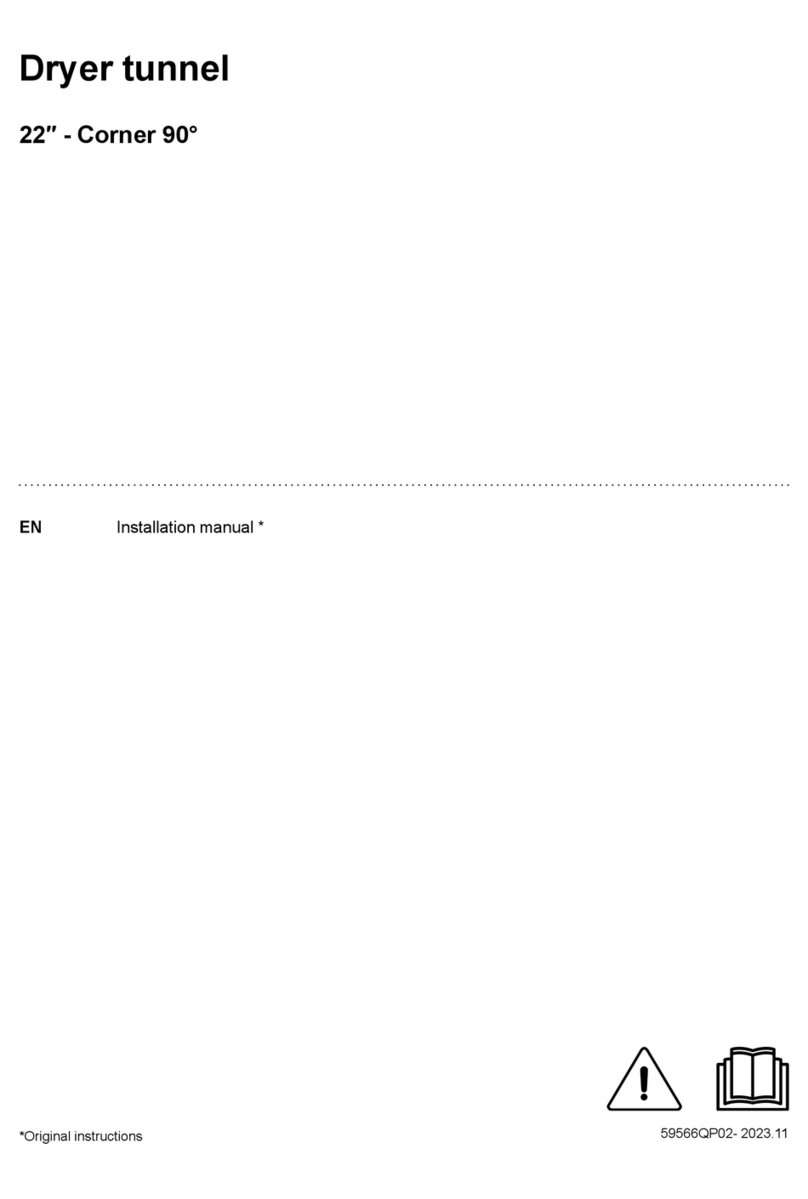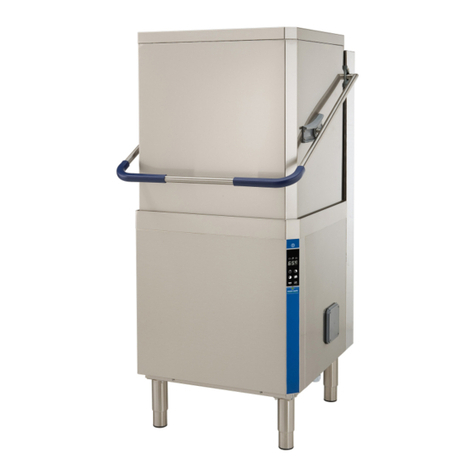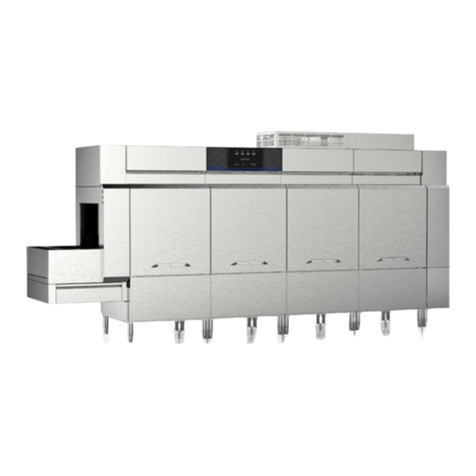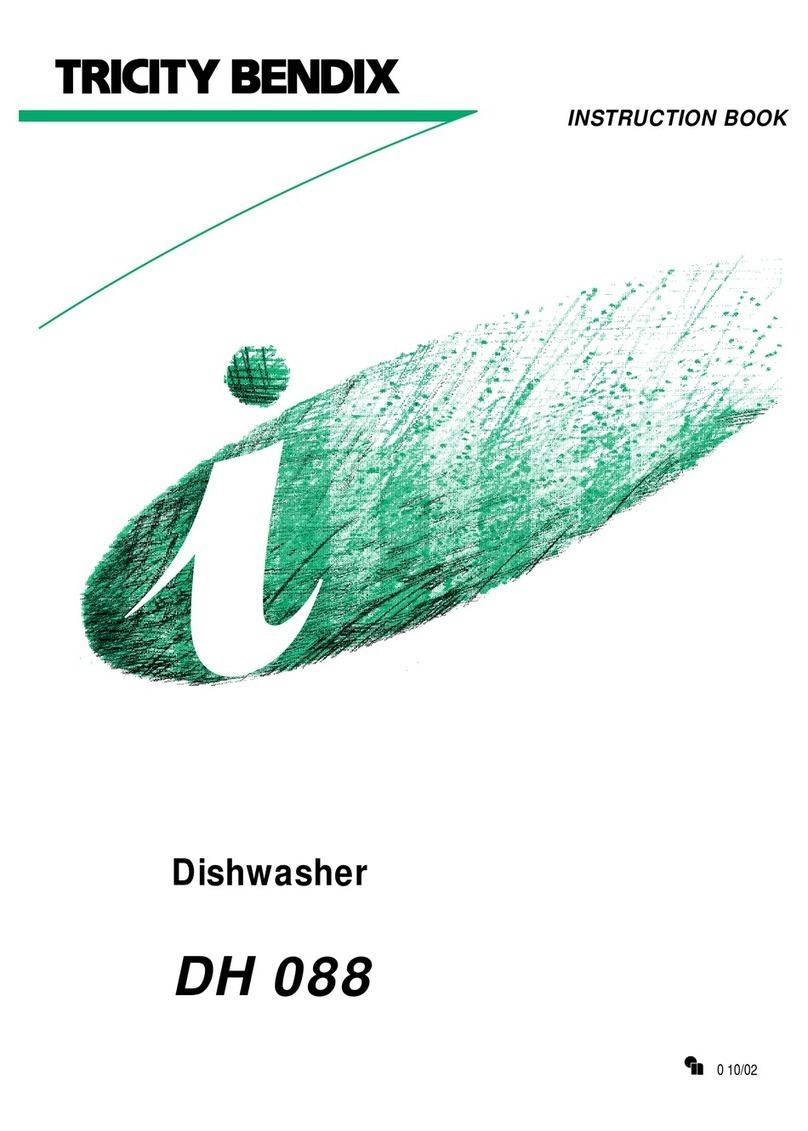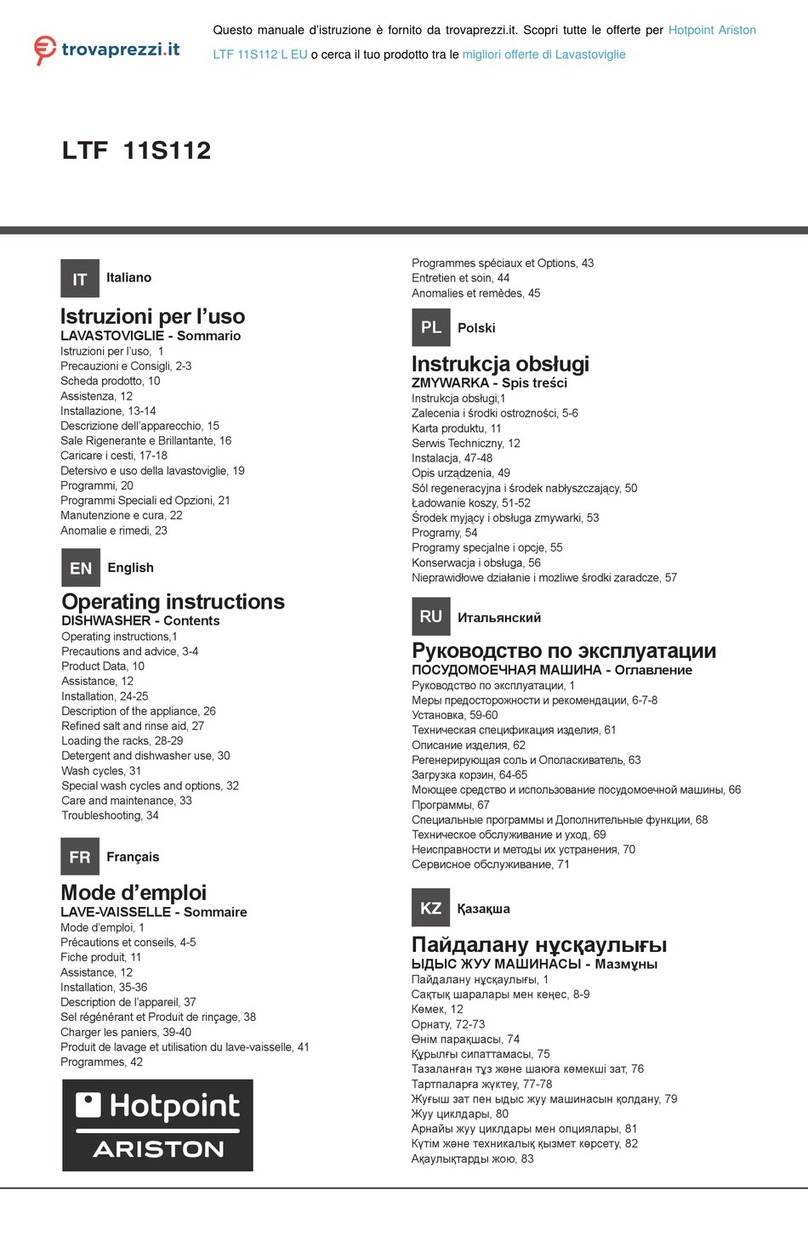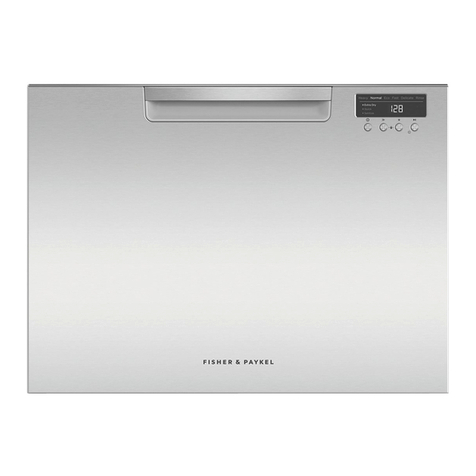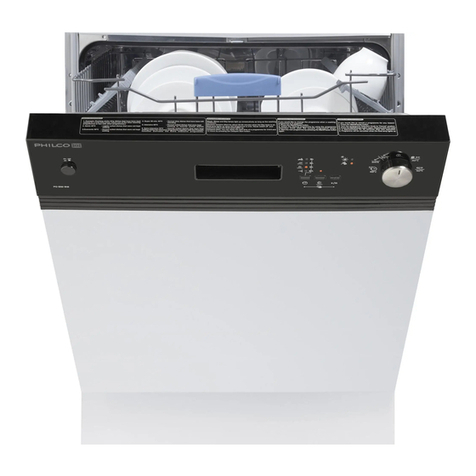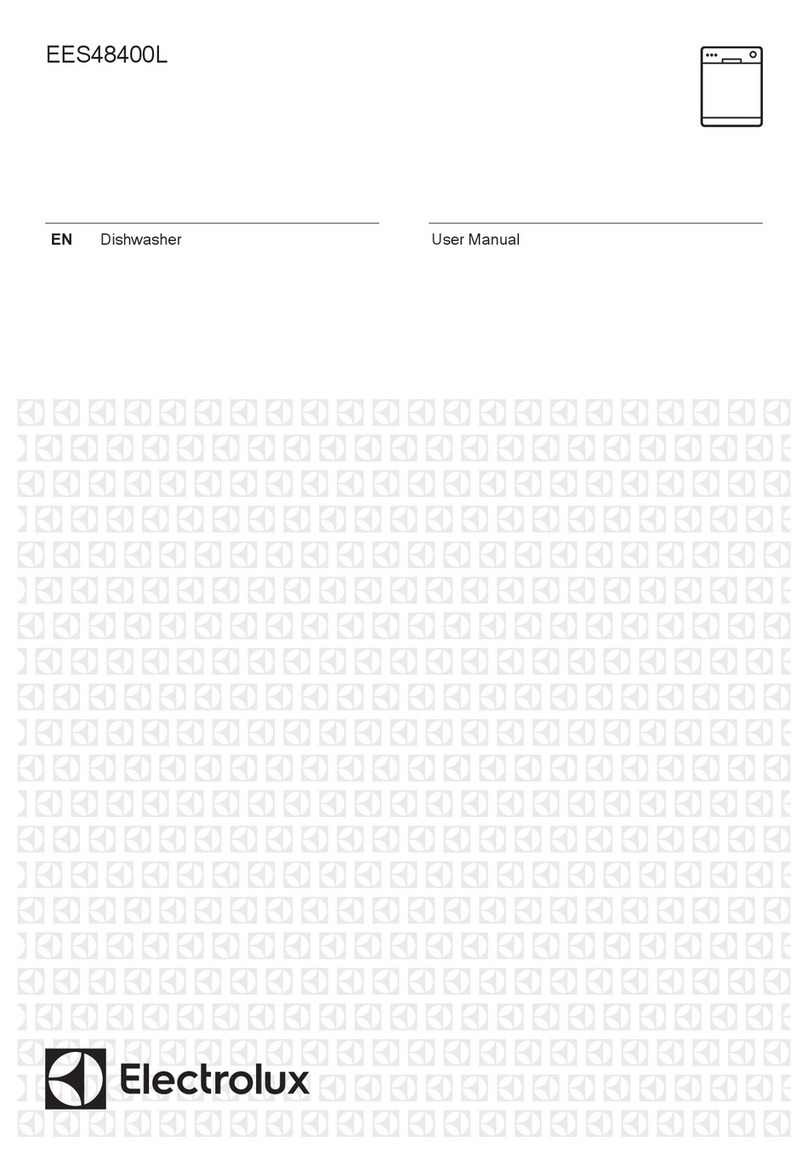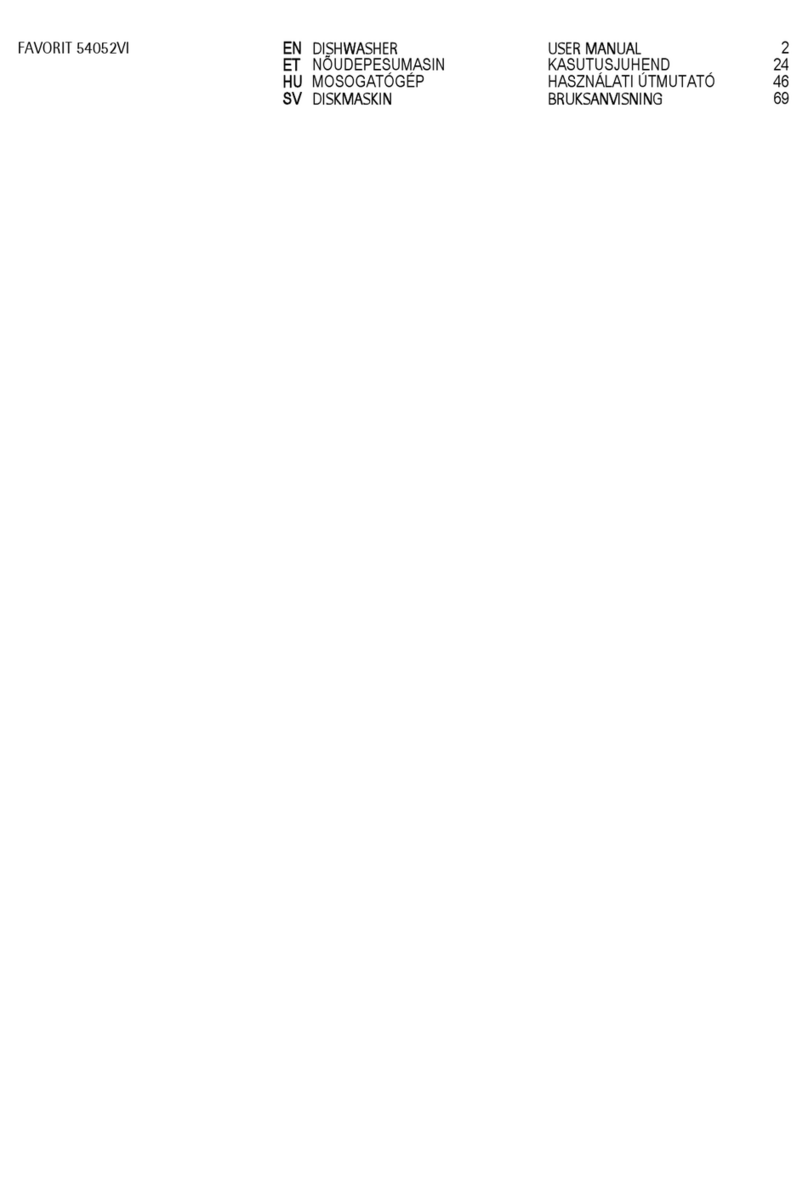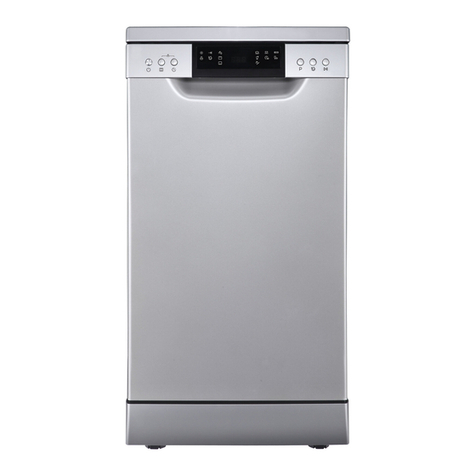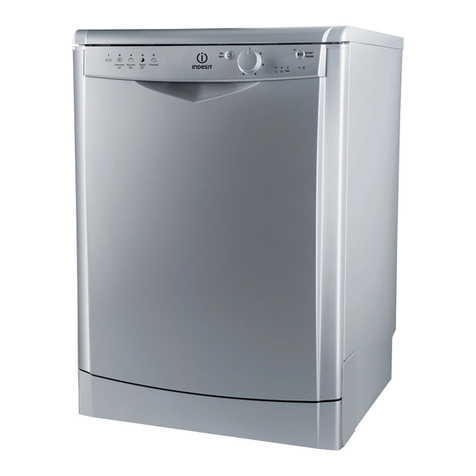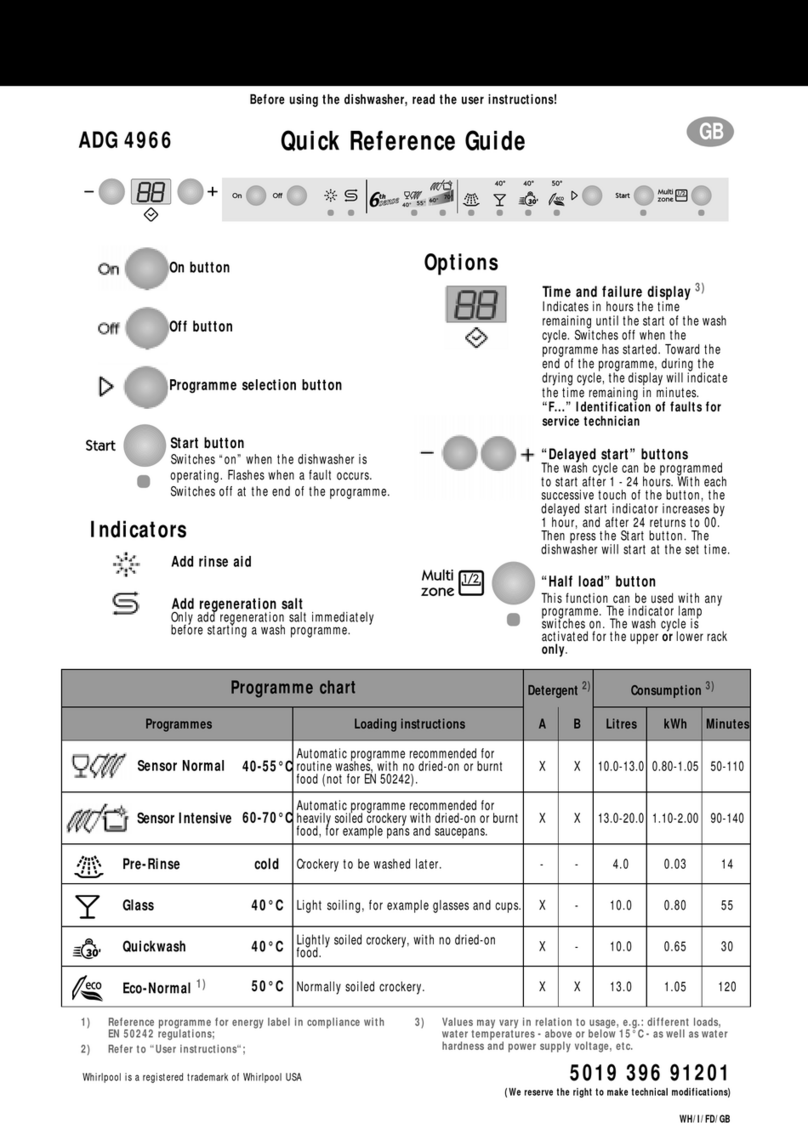Electrolux Professional EMRA060 User manual

Rack type dishwasher
EMRA060
EN Installation manual *
*Original instructions 59566V800- 2020.06

2
Installation diagram EMRA060 right to left
2670
2095
79847
80
798
187
187
775 565
798
80
47
300
22 Ø
913
300
795
1325
653
401
140 330
895
50
200
3270
103100
40
72
576 40
167
150 1635
583
856 30
875 490
107
330
530
510
DEQ
U
EO
ES
ES
EI
EI
V
EO
ES
XI
XD
XD
XR
XP
ES
XDXD
EI
WI
CWI
EIEI
XI XR
D
V
ES
EI
EO
ES
EI
EI
WI
CWI

3
Installation diagram EMRA060 left to right
895
795
1325 50
653
401
200
140 330
103 100
3270
798 798
187
47
2670
775 565
2095
798
80
47
300
187
22 Ø
913
80
300
40
576
40
167
150 1635
107 583
856
875
330
490
30
72
530
510
XD
XR
EI
WI
CWI
XDXI
V
D
EI EI
D
EQ
V
EO
ES
ES
XP
U
EO
ES
ES
WI
CWI
EIEI
ES
EI
EOES
XI
XD
XD
XR
EI
EI

4
D = Drain outlet ⌀=50mm (external)
EI = Electricity inlet
EO = Electricity outlet
ES = Electrical signal IN/OUT
EQ = Equipotential screw
XD= Pipe inlet for detergent
XR= Pipe inlet for rinse-aid
XI= Pipe inlet for delime
XP= Chemicals probe/sensor
WI = Water inlet G 3/4″
CWI = Cold water inlet G 3/4″
U = USB
V = Vent(s)

5
Foreword
The installation, use and maintenance manual (hereinafter Manual) provides the user with information necessary for correct
and safe use of the machine (or “appliance“).
The following must not be considered a long and exacting list of warnings, but rather a set of instructions suitable for improving
machine performance in every respect and, above all, preventing injury to persons and animals and damage to property due to im-
proper operating procedures.
All persons involved in machine transport, installation, commissioning, use and maintenance, repair and disassembly must con-
sult and carefully read this manual before carrying out the various operations, in order to avoid wrong and improper actions that
could compromise the machine's integrity or endanger people. Make sure to periodically inform the user regarding the safety regu-
lations. It is also important to instruct and update personnel authorised to operate on the machine, regarding its use and
maintenance.
The manual must be available to operators and carefully kept in the place where the machine is used, so that it is always at hand
for consultation in case of doubts or whenever required.
If, after reading this manual, there are still doubts regarding machine use, do not hesitate to contact the Manufacturer or the au-
thorised Service Centre to receive prompt and precise assistance for better operation and maximum efficiency of the machine.
During all stages of machine use, always respect the current regulations on safety, work hygiene and environmental protection. It
is the user's responsibility to make sure the machine is started and operated only in optimum conditions of safety for people, ani-
mals and property.
IMPORTANT
• The manufacturer declines any liability for operations carried out on the appliance without respecting the instructions
given in this manual.
• The manufacturer reserves the right to modify the appliances presented in this publication without notice.
• No part of this manual may be reproduced.
• This manual is available in digital format by:
– contacting the dealer or reference customer care;
– downloading the latest and up to date manual on the web site;
• The manual must always be kept in an easily accessed place near the machine. Machine operators and mainte-
nance personnel must be able to easily find and consult it at any time.

6
Contents
A SAFETY INFORMATION.........................................................................................................................8
A.1 General information ......................................................................................................................8
A.2 General safety .............................................................................................................................8
A.3 Personal protection equipment ........................................................................................................9
A.4 Transport, handling and storage ......................................................................................................9
A.5 Installation and assembly ............................................................................................................. 10
A.6 Water connection........................................................................................................................ 10
A.7 Electrical connection ................................................................................................................... 10
A.8 Parts and accessories ................................................................................................................. 11
A.9 Disposal of packing..................................................................................................................... 11
A.10 Machine disposal........................................................................................................................ 11
B GENERAL INFORMATION .................................................................................................................... 11
B.1 Introduction ............................................................................................................................... 11
B.2 Definitions................................................................................................................................. 12
B.3 Machine and manufacturer's identification data ................................................................................. 12
B.4 Additional indications................................................................................................................... 12
B.4.1 How to interpret the factory description .................................................................................. 13
B.5 Responsibility ............................................................................................................................ 13
B.6 Copyright.................................................................................................................................. 13
B.7 Keeping the manual .................................................................................................................... 13
B.8 Recipients of the manual .............................................................................................................. 13
C TECHNICAL DATA............................................................................................................................... 13
C.1 Main technical characteristics........................................................................................................ 13
C.2 Type reference........................................................................................................................... 14
C.3 Characteristics of power supply ..................................................................................................... 15
D TRANSPORT, HANDLING AND STORAGE .............................................................................................. 15
D.1 Introduction ............................................................................................................................... 15
D.2 Transport: Instructions for the carrier............................................................................................... 15
D.3 Handling................................................................................................................................... 15
D.3.1 Procedures for handling operations....................................................................................... 15
D.3.2 Shifting ........................................................................................................................... 15
D.3.3 Placing the load ................................................................................................................ 15
D.4 Storage .................................................................................................................................... 15
D.5 Unpacking ................................................................................................................................ 15
E INSTALLATION AND ASSEMBLY ........................................................................................................... 16
E.1 Introduction ............................................................................................................................... 16
E.2 Customer responsibilities ............................................................................................................. 16
E.3 Machine space limits................................................................................................................... 16
E.4 Extraction hood.......................................................................................................................... 16
E.5 Positioning ................................................................................................................................ 17
E.6 Disposal of packing..................................................................................................................... 17
E.7 Plumbing connections ................................................................................................................. 17
E.8 Constructional modifications ......................................................................................................... 18
E.9 Installation of rack handling systems............................................................................................... 18
E.10 Arrangement for mechanical connection (only for Electrolux rack handling system non motor
operated).................................................................................................................................. 18
E.11 Arrangement for electrical connection (only for Electrolux rack handling system motor operated) ................. 19
E.12 Installation of the end limit switch ................................................................................................... 19
E.12.1 Prearrangement for electrical connection ............................................................................... 19
E.13 Positioning of emergency switches ................................................................................................. 19
E.13.1 Electrical connection.......................................................................................................... 20
E.14 Exhaust fan electrical connection ................................................................................................... 20
E.15 Installation of detergent/rinse aid dispensers .................................................................................... 20
E.15.1 Rinse aid dispenser ........................................................................................................... 21
E.15.2 Liquid detergent dispenser .................................................................................................. 21
E.15.3 Solid detergent dispenser ................................................................................................... 21
E.15.4 Delime hose connection ..................................................................................................... 21
E.16 Dispensers electrical connection .................................................................................................... 21
E.16.1 Rinse aid dispenser ........................................................................................................... 22
E.16.2 Liquid detergent dispenser .................................................................................................. 22
E.16.3 Solid detergent dispenser ................................................................................................... 22
E.17 Electrical connections.................................................................................................................. 22
E.18 Fitting curtains ........................................................................................................................... 22
F CONTROL PANEL DESCRIPTION .......................................................................................................... 23
F.1 Control panel overview ................................................................................................................ 23
F.2 Touch screen description.............................................................................................................. 23
G COMMISSIONING ............................................................................................................................... 24
G.1 Preliminary checks, adjustments and operational tests ....................................................................... 24
G.2 Electrical and plumbing connection................................................................................................. 24
G.3 Positioning and fitting of the tank components................................................................................... 24
G.4 Positioning and fitting of the washing and rinse arms .......................................................................... 25
G.5 Positioning and fitting of the curtains ............................................................................................... 25

7
G.6 First starting .............................................................................................................................. 25
H BASIC MACHINE SETUP...................................................................................................................... 26
H.1 Enter into service menu ............................................................................................................... 26
H.2 User Interface settings menu......................................................................................................... 26
H.3 Installation settings menu ............................................................................................................. 27

8
A SAFETY INFORMATION
A.1 General information
To ensure safe use of the machine and a proper understanding of the manual it is
necessary to be familiar with the terms and typographical conventions used in the
documentation. The following symbols are used in the manual to indicate and identify the
various types of hazards:
WARNING
Danger for the health and safety of operators.
WARNING
Danger of electrocution - dangerous voltage.
CAUTION
Risk of damage to the machine or the product.
IMPORTANT
Important instructions or information on the product
Equipotentiality
Read the instructions before using the appliance
Clarifications and explanations
A.2 General safety
• The machine must not be used by people (including children) with limited physical,
sensory or mental abilities or without experience and knowledge of it, unless instructed
in its use and supervised by those responsible for their safety.
– Do not let children play with the machine.
– Keep all packaging and detergents away from children.
– Cleaning and user maintenance shall not be made by children without supervision.
• For suitable personal protection equipment, refer to chapter “A.3 Personal protection
equipment“.
• Several illustrations in the manual show the machine, or parts of it, without guards or
with guards removed. This is purely for explanatory purposes. Do not install the machine
without the guards or with the protection devices deactivated.
• Do not remove, tamper with or make illegible the safety, danger and instruction signs
and labels on the machine.
• Do not remove or tamper with the machine’s safety devices.
• Before carrying out any machine installation, always consult the installation manual,
which gives the correct procedures and contains important information on safety.
• Unauthorized personnel must not enter the work area.
• Remove any flammable products or items from the work area.

9
• Machine positioning, installation and disassembly must be carried out by the specialised
personnel in conformity with the current safety regulations, regarding the equipment
used and the operating procedures.
A.3 Personal protection equipment
Summary table of the Personal Protection Equipment (PPE) to be used during the various stages of the machine's
service life.
Stage Protective
garments
Safety
footwear
Gloves Glasses Safety
helmet
Transport —● ○ —○
Handling ● ● ○ — —
Unpacking ○ ● ○ — —
Installation ○ ● ●1— —
Normal use ● ● ●2○—
Adjustments ○ ● — — —
Routine
cleaning
○ ● ●1ˉ3○—
Extraordi-
nary
cleaning
○ ● ●1ˉ3○—
Maintenance ○ ● ○ — —
Dismantling ○ ● ○ ○ —
Scrapping ○ ● ○ ○ —
Key:
●PPE REQUIRED
○PPE AVAILABLE OR TO BE USED IF NECESSARY
—PPE NOT REQUIRED
1. During these operations, gloves must be cut-resistant. Failure to use the personal protection equipment by
operators, specialized personnel or users can involve exposure to damage to health (depending on the
model).
2. During these operations, gloves must be heatproof and suitable for contact with water and the substances
used (refer to the safety data sheet of the substances used for the information regarding the required PPE).
Failure to use the personal protection equipment by operators, specialised personnel or users can involve
exposure to chemical risk and cause possible damage to health (depending on the model).
3. During these operations, gloves must be suitable for contact with chemical substances used (refer to the
safety data sheet of the substances used for information regarding the required PPE). Failure to use the
personal protection equipment by operators, specialized personnel or users can involve exposure to
chemical risk and cause possible damage to health (depending on the model).
A.4 Transport, handling and storage
• Due to their size, the machines cannot be stacked on top of each other during transport,
handling and storage; this eliminates any risks of loads tipping over due to stacking.
• Do not stand under suspended loads during loading or unloading operations.
Unauthorized personnel must not enter the work area.
• The weight of the appliance alone is not sufficient to keep it steady.
• For machine lifting and anchoring, do not use movable or weak parts such as: casings,
electrical raceways, pneumatic parts, etc.

10
• Do not push or pull the machine to move it, as it may tip over. Use proper tool to lift the
machine.
• Machine transport, handling and storage personnel must be adequately instructed and
trained regarding the use of lifting systems and personal protection equipment suitable
for the type of operation carried out.
A.5 Installation and assembly
• Follow the installation instruction supplied with the machine.
• Do not install a damaged machine. Any missing or faulty parts must be replaced with
original parts.
• Do not make any modifications to the parts supplied with the machine.
• Disconnect the machine from the power supply before carrying out any installation
procedure. Connect the machine to the power supply only at the end of the installation.
• The machine is not suitable for installation outdoors and/or in places exposed to
atmospheric agents (rain, direct sunlight, freeze, humid and dusty location, etc.).
• Do not install the machine over 2000 meters above sea level.
• Make sure that the floor where you install the machine is flat, stable, heat resistant and
clean.
• Use a ladder with suitable protection for work on machines with high accessibility.
A.6 Water connection
• The plumbing connections must be carried out by a specialised personnel.
• The machine is to be connected to the water mains using the new supplied hose-sets.
Do not use old hose sets.
• Always use a new set of joints if you remove and re-install the water inlet pipe to the
machine.
• Before connection to new pipes, pipes not used for a long time, where repair work has
been carried out or new devices fitted (water meters, etc.), let the water flow until it is
clean and clear.
• The operating water pressure (minimum and maximum) must be between:
– 1.5 bar [150 kPa] and 6 bar [600 kPa] for models with ESD;
• Make sure that there are no visible water leaks during and after the first use of the
machine.
• Install an approved dual check valve upstream according to the regulation of the
installation country.
A.7 Electrical connection
• Work on the electrical systems must only be carried out by a specialised personnel.
• Make sure that the electrical information on the rating plate agrees with the power supply.
• Make sure to install the machine in accordance with the safety regulations and local
laws of the country where used.
• If the power cable is damaged it must be replaced by the Customer Care Service or in
any case by specialised personnel, in order to prevent any risk.
• The machine must be correctly earthed. The manufacturer is not responsible for the
consequences of an inadequate earthing system.
• If present, connected the machine to the equipotential protection circuit .
• To protect the power supply of the machine against short circuits and/or overloads,
install a thermal fuse or a suitable automatic thermal magnetic circuit breaker, ADS
(Automatic Disconnection of Supply).

11
• To protect the power supply of the machine against current leakages, install a high-
sensitivity manual reset RCD (Residual Current Device), suitable for overvoltage
category III.
• For protection against indirect contacts (depending on the type of supply provided for
and connection of earths to the equipotential protection circuit ) refer to point 6.3.3 of
EN 60204-1 (IEC 60204-1) with the use of protection devices that ensure automatic cut-
off of the supply in case of isolation fault in the TN or TT systems or, for IT systems, the
use of isolation controllers or differential current protection devices to activate automatic
power disconnection (an isolation controller must be provided for indicating a possible
first earth fault of a live part, unless a protection device is supplied for switching off the
power in case of a such a fault. This device must activate an acoustic and/or visual
signal which must continue for the entire duration of the fault). For example: in a TT
system, a residual current device with cut-in current (e.g. 30 mA) coordinated with the
earthing system of the building where the machine is located must be installed ahead of
the supply.
• Make sure to install an emergency switch at the infeed and outfeed of the rack-type
dishwasher. For all additional modules installed later, move the emergency switch at the
ends of the equipment.
• For all the additional modules installed later, make sure that the power cable supply is
properly sized.
A.8 Parts and accessories
Use only original accessories and/or spare parts. Failure to use original accessories and/or
spare parts will invalidate the original manufacturer warranty and may render the machine
not compliant with the safety standard.
A.9 Disposal of packing
• Dispose of each packaging items respecting the current regulation in the country of
installation.
A.10 Machine disposal
• Work on the electrical equipment must only be carried out by a specialised personnel,
with the power supply disconnected.
• Dismantling operations must be carried out by specialised personnel.
• Make the appliance unusable by removing the power cable and any compartment
closing devices, to prevent the possibility of someone becoming trapped inside.
• Refer to “A.3 Personal protection equipment“ for suitable personal protection equipment.
• When scrapping the machine, the “CE“ marking, this manual and other documents
concerning the appliance must be destroyed.
IMPORTANT
Save these instructions carefully for further consultation by the various
operators.
B GENERAL INFORMATION
B.1 Introduction
Given below is some information regarding the intended use of
this appliance, its testing, and a description of the symbols
used (that identifies the type of warning), the definitions of
terms used in the manual and useful information for the
appliance user.

12
B.2 Definitions
Listed below are the definitions of the main terms used in the
manual. It is advisable to read them carefully before use.
Operator machine installation, adjustment, use,
maintenance, cleaning, repair and trans-
port personnel.
Manufacturer Electrolux Professional SpA or any other
service centre authorised by Electrolux
Professional SpA.
Operator for
normal
machine use
an operator who has been informed and
trained regarding the tasks and hazards
involved in normal machine use.
Customer
Care service
or specialised
technician
an operator instructed/trained by the
Manufacturer and who, based on his
professional and specific training, experi-
ence and knowledge of the accident-
prevention regulations, is able to appraise
the operations to be carried out on the
machine and recognise and prevent any
risks. His professionalism covers the
mechanical, electrotechnical and elec-
tronics fields.
Danger source of possible injury or harm to health.
Hazardous
situation
any situation where an operator is
exposed to one or more hazards.
Risk a combination of probabilities and risks of
injury or harm to health in a hazardous
situation.
Protection
devices
safety measures consisting of the use of
specific technical means (guards and
safety devices) for protecting operators
against risks.
Guard an element of a machine used in a specific
way to provide protection by means of a
physical barrier.
Safety device a device (other than a guard) that elimi-
nates or reduces the risk; it can be used
alone or in combination with a guard.
Customer the person who purchased the machine
and/or who manages and uses it (e. g.
company, entrepreneur, firm).
Emergency
stop device
a group of components intended for the
emergency stop function; the device is
activated with a single action and pre-
vents or reduces damage to persons/
machines/property/animals.
Electrocution an accidental discharge of electric current
on a human body.
B.3 Machine and manufacturer's
identification data
An example of the marking or data plate on the machine is
given below:
The data plate gives the product identification and technical
data. The meaning of the various information given on it is
listed below:
F.Mod. factory description of product
Comm.Model commercial description
PNC production number code
Ser.Nr. serial number
V power supply voltage
Hz power supply frequency
kW max. power input
Type ref. list of acronyms used to identify the
type of machine, uniquely
CE CE marking
IPX5 dust and water protection rating
Electrolux Professio-
nal SpA Viale Treviso
15 33170 Pordenone
Italy
manufacturer
The data plate is located on the front panel of the equipment.
Fig. 1 Data plate position (machine right)
Fig. 2 Data plate position (machine left)
IMPORTANT
When installing the machine, make sure the
electrical connection is carried out in compliance
with that specified on the data plate.
NOTE!
Refer to the data given on the machine's data plate
for relations with the Manufacturer (e.g. when
ordering spare parts, etc.).
B.4 Additional indications
The drawings and diagrams given in the manual are not in
scale. They supplement the written information with an outline,
but are not intended to be a detailed representation of the
machine supplied
The numerical values given on the machine installation
diagrams refer to measurements in millimeters and/or inches.
Conventionally, the machine are depicted with the rack feed
side on the right (“R“); machine with left rack feed (“L“) are
depicted only if necessary, in which case the side will be
expressly specified.
ELX Made in EU 2017F.Mod. Comm.ModelPNC Ser.Nr. EL V 50 Hz kWype ref.
Electrolux Professional spa - Viale reviso, 15 - 33170 Pordenone (Italy)
IPX5
ELX Made in EU 2017F.Mod. Comm.ModelPNC Ser.Nr. EL V 50 Hz kW
Electrolux Professional spa - Viale reviso, 15 - 33170 Pordenone (Italy)
IPX5
ELX Made in EU 2016F.Mod. Comm.ModelPNC Ser.Nr. EL V 50 Hz kW
Electrolux Professional spa - Viale reviso, 15 - 33170 Pordenone (Italy)
IPX5

13
Due to its size, the machine is sometimes shown schematically
divided into its functional modules in order to provide a
complete view.
B.4.1 How to interpret the factory description
The factory description on the data plate has the following
meaning:
(1) (2) (3)
E MR A060
Description Possible variables
(1) Brand E = Electrolux
(2) Machine Type MR = multi rinse
(3) Options A060 = Compliant with A060
level according to EN 15883-1
Standard
B.5 Responsibility
The Manufacturer declines any liability for damage and
malfunctioning caused by:
• non-compliance with the instructions contained in this
manual;
• repairs not carried out in a workmanlike fashion, and
replacements with parts different from those specified in
the spare parts catalogue (the fitting and use of non-original
spare parts and accessories can negatively affect machine
operation and invalidates the original manufacturer
warranty);
• operations carried out by non-specialised personnel;
• unauthorized modifications or operations;
• missing, lack or inadequate maintenance;
• improper machine use;
• unforeseeable extraordinary events;
• use of the machine by uninformed and / or untrained
personnel;
• non-application of the current provisions in the country of
use, concerning safety, hygiene and health in the workplace.
The Manufacturer declines any liability for damage caused by
arbitrary modifications and conversions carried out by the user
or the Customer.
The employer, workplace manager or service technician are
responsible for identifying and choosing adequate and suitable
personal protection equipment to be worn by operators, in
compliance with regulations in force in the country of use.
The Manufacturer declines any liability for inaccuracies con-
tained in the manual, if due to printing or translation errors.
Any supplements to the installation, use and maintenance
manual the Customer receives from the Manufacturer will form
an integral part of the manual and therefore must be kept
together with it.
B.6 Copyright
This manual is intended solely for consultation by the operator
and can only be given to third parties with the permission of
Electrolux Professional SpA.
B.7 Keeping the manual
The manual must be carefully kept for the entire life of the
machine, until scrapping. The manual must stay with the
machine in case of transfer, sale, hire, granting of use or
leasing.
B.8 Recipients of the manual
This manual is intended for:
• the carrier and handling personnel;
• installation and commissioning personnel;
• specialised personnel - Customer Care service (see service
manual).
C TECHNICAL DATA
C.1 Main technical characteristics
Common
Power supply voltage V 380 - 415 3N
Frequency Hz 50
Power cable Type H07RN-F
N° x mm25x25
Main switch A 125A 3P+N
Supply water pressure bar [kPa] ESD: 1.5 bar [150 kPa]...6 bar
[600 kPa]
Hot water supply temp. ℃10-65
[50]1
Cold water supply temp. ℃10-30
Concentration of chlorides in water ppm <20
Supply water hardness °f/°d/°e 14/8/10
Electric conductivity of water µS/cm <400
Protection rating IPX5
Nr. wash speeds 3
1. Hot water temperature recommended
Machine
Capacity wash at speed 3 racks/h 150
Water consumption l/h 140
Max. power absorbed kW 59.8

14
Machine (cont'd.)
Max. current absorbed A 86.5
Legal noise level Leq1dB(A) LpA:58dB - KpA:1.5dB
1. The noise emission values have been obtained according to EN ISO 11204.
Prewash
Tank capacity l 70
Temperature (min - max) ℃40 - 60
Pump power kW 1.5
Tank heating element kW 14
Max. current absorbed A 22
Wash
Tank capacity l 70
Temperature ℃75
Pump power kW 1.5
Tank heating element kW 20
Max. current absorbed A 32
Duo Rinse
Tank capacity l 20
Temperature ℃75 - 80
Pump power kW 0.32
Current absorbed by pump A 0.5
Triple Rinse
Tank capacity l 20
Temperature ℃75 - 80
Pump power kW 0,32
Tank heating element kW 7
Max. current absorbed A 10.1
Final Rinse
Temperature ℃90
Boiler capacity l 12
Pump power kW 0.55
Boiler heating elements kW 14
Max. current absorbed A 20.6
C.2 Type reference
Legend
Prewash module Machine module Dryer module
PW Prewash MR Multi Rinse D Dryer
M Medium (22″) M Medium (22″)
L Large (35″) L Large (35″)
C Corner
E Electric E Electric E Electric
E Energy Saving Device
W WRAS & Watermark
approval
W “WRAS“ & Watermark
approval

15
Machine with Energy Saving Device (ESD)
Model PW
module Machine module DR Module Max POWER
(KW)
Max Current
(A)
EMRA060
PWLE MREE
MREEW1
47.3 68.3
DME 51.7 74.7
DLE 55.8 80.6
DCE 55.8 80.6
DLE DME 60.1 86.8
DLE DCE 64.3 93
1. Suitable for UK & Australia
CAUTION
For all the additional modules installed later. make sure that the power cable supply is properly
sized.
C.3 Characteristics of power supply
The AC power supply to the machine must meet the following conditions:
• max. voltage variation ± 6%
• max. frequency variation ± 1% continuous ± 2% for a short period.
Harmonic distorsion, unbalanced three-phase supply voltage, voltage pulses, interruption, dips and the other electric character-
istics must respect the provisions of point 4.3.2 of Standard EN 60204-1 (IEC 60204-1).
D TRANSPORT, HANDLING AND STORAGE
WARNING
Refer to “Safety Information“.
D.1 Introduction
Transport (i. e. transfer of the machine from one place to
another) and handling (i. e. transfer inside workplaces) must
occur with the use of special and adequate means.
CAUTION
The machine must only be transported, handled and stored
by specialised personnel, who must have:
• specific technical training and experience in the use of
lifting systems;
• knowledge of the safety regulations and applicable laws
in the relevant sectors;
• knowledge of the general safety rules;
• personal protection equipment suitable for the type of
operation carried out;
• the ability to recognize and avoid any possible hazard.
D.2 Transport: Instructions for the carrier
IMPORTANT
The transported load can shift:
• when braking;
• when accelerating;
• in corners;
• on rough roads.
D.3 Handling
Arrange a suitable area with flat floor for machine unloading
and storage operations.
D.3.1 Procedures for handling operations
Before lifting:
• send all operators to a safe position and prevent persons
from entering the handling area;
• make sure the load is stable;
• make sure no material can fall during lifting. Manoeuvre
vertically in order to avoid impacts;
• handle the machine, keeping it at minimum height from the
ground.
For correct and safe lifting operations:
• use the type of equipment most suitable for characteristics
and capacity (e.g. electric pallet truck or lift truck);
• cover sharp edges;
• check the forks and lifting procedures according to the
instructions given on the packing.
D.3.2 Shifting
The operator must:
• have a general view of the path to be followed;
• stop the manoeuvre in case of hazardous situations.
D.3.3 Placing the load
• Before placing the load, make sure the way is free and that
the floor is flat and can take the load.
• Remove the appliance from the wooden pallet, move it to
one side, then slide it onto the floor.
D.4 Storage
The machine and/or its parts must be stored and protected
from damp, in a non-aggressive place, free of vibrations and
with room temperatures between -10℃[14℉] and 50℃
[122℉].
The place where the machine is stored must have a flat
support surface to avoid deforming the machine or damage to
the support feet.
CAUTION
Do not make modifications to the parts
supplied with the appliance. Any missing
or faulty parts must be replaced with
original parts.
D.5 Unpacking
IMPORTANT
Immediately check for any damage caused during
transport.
Inspect the packaging before and after unloading.

16
1. Remove the packaging.
Take care when unpacking and handling of the appliance
to not cause any shocks on itself.
2. Keep all the documentation contained in the packaging.
Note
• The forwarder is responsible for the goods during transport
and delivery.
• Make a complaint to the forwarder in case of visible or
hidden damage.
• Specify any damage or shortages on the dispatch note.
• The driver must sign the dispatch note: the forwarder can
reject the claim if the dispatch note is not signed (the
forwarder can provide the necessary form).
• For hidden damage or shortages becoming apparent only
after unpacking, request the forwarder for inspection of the
goods within and no later than 15 days after delivery.
E INSTALLATION AND ASSEMBLY
WARNING
Refer to “Safety Information“.
E.1 Introduction
WARNING
Make sure that the switch disconnector of the
machine is locked in the Off position - “O“.
E.2 Customer responsibilities
The Customer must provide for the following:
• installation of an adequate electrical power supply ahead of
the appliance, according to the equipment’s technical
specifications (C TECHNICAL DATA and C.3 Character-
istics of power supply);
• the equipotential connection of the workplace electrical
system to the metal structure of the machine by means of a
copper cable of adequate section (see position “EQ“ in
Installation diagram);
• adducting for the electrical connection between the work-
place electric panel and the equipment;
• the water supply and drain connections and other con-
nections as indicated in C TECHNICAL DATA and in the
paragraph E.7 Plumbing connections;
E.3 Machine space limits
• A suitable space must be left around the machine (for
operations, maintenance, for a correct air exchange, etc.).
• This space must be increased in case of use and/or transfer
of other equipment and/or means or if exit routes are
necessary inside the workplace.
CAUTION
Install the machine at a distance of not
less than 50 mm from the wall so as not to
affect correct ventilation of internal
components.
E.4 Extraction hood
Make sure to position the possible extraction hood at a
distance of not less than 400 mm from the machine so as not
to compromise machine operation.
The extractor hood is installed to remove the steam emitted by
the machine. The hood air delivery must be calculated taking
into account the machine model, the type of installation and the
work environment where installed.
Model Qtot (VDI2052)
EMRA060 2000 m3/h
50 mm
min 400 mm
Qtot
Qtot
Qtot
min 400 mm
min 400 mm
Qtot
Qtot

17
E.5 Positioning
NOTE!
Make sure that the room temperature where you
install the machine must be at least 18℃[64.5℉].
The machine must be taken to the place of installation and the
packing base removed only when being installed.
Arranging the machine:
• Position the machine in the required place.
• Adjust the equipment by turning the special adjustable feet.
To facilitate the perfect drainage of the water during the
drain cycle, adjust the machine with a minimum inclination
of 3° on the drain side.
• Adjust the machine crosswise with a minimum inclination of
3° in order to facilitate the drainage of the dirty water from
the tanks.
• Carefully remove the protective film from the outer panels
without tearing it, to avoid leaving traces of glue.
E.6 Disposal of packing
The packing must be disposed of in compliance with the
current regulations in the country where the appliance is used.
All the packing materials are environmentally friendly.
They can be safely kept, recycled or burned in an appropriate
waste incineration plant. Recyclable plastic parts are marked
as follows:
Polyethylene
• Outer wrapping
• Instructions bag
Polypropylene
• Straps
Polystyrene foam
• Corner protectors
The parts in wood and cardboard can be disposed of,
respecting the current regulations in the country where the
machine is used.
E.7 Plumbing connections
IMPORTANT
Watermark labelled appliances must be installed in
accordance with AS/NZS 3500.1 and drainage to
be in accordance with 3500.2.
Install the machine water inlets and drain pipes according to
the plumbing circuit and installation diagrams.
A booster pump must be installed ahead of the machine, if:
• the water pressure is less than 1.5 bar [150 kPa] for “ESD“
models;
If the pressure is more than6 bar [600 kPa], a pressure
reducing valve must be installed on the inlet pipe. The supply
water temperature is related to the machine setup.
Water connection ISO 228/1 DN 20 (G3/4”)
• Cold water inlet temperature:
– 10-30℃
• Hot water inlet temperature:
– 10-65℃
– The recommended hot water temperature is: 50℃
• Water inlet pressure:
– 1.5 bar [150 kPa] - 6 bar [600 kPa] at 0,3 l/sec
Drain outlet hose connection
• Connect the drain outlet hose to the main drain pipe, fitting a
trap, or place the outlet pipe over an “S“ trap set into the
floor.
Fig. 3 Plumbing connection for left machine
A
B
[3/4 G ]

18
Fig. 4 Plumbing connection for right machine
CAUTION
For every connection, installing a cut-off
valve “B“ and a pressure gauge “A“
between the machine and the mains.
Pay attention to seal every component in
order to avoid water leaks.
NOTE!
Connection pipes with anti-return/back flow protec-
tion and check valve and on/off valve are available
as optional accessories.
To ensure efficient machine operation, install a
water treatment device on the dishwasher inlet
connection piping if:
• the water hardness exceeds 14°fH/8°dH/10°eH
(a water softener and/or a water demineralizer);
• the water concentration of chlorides in water
exceeds 20 ppm (a reverse osmosis device).
E.8 Constructional modifications
The Manufacturer provides for the possibility of connecting the
rack-type dishwasher to rack handling systems included in the
Electrolux Professional product catalogue, with the possibility
of obtaining various configurations. The “EC“ Conformity
Declaration provided with the machine also envisages these
configurations. The Manufacturer does not provide for the
possibility of making other constructional modifications to the
machine, but allows the execution of other types of combina-
tions with systems different from those described above (in
order to create a series of machines arranged and controlled in
an integral way), as illustrated in this documentation. In which
case it is necessary to comply with provisions of the applicable
European Directives or current regulations in the country of
use, and obtain the required certifications. The Manufacturer
declines any liability for damage caused by arbitrary modifica-
tions and conversions carried out by the user or third parties.
For requests or for further information, contact Electrolux
Professional SpA - Via Treviso, 15 - 33170 Pordenone - Italy.
E.9 Installation of rack handling systems
WARNING
Make sure that the switch disconnector of the
machine is locked in the Off position - “O“.
The arrangements for the mechanical and electrical connec-
tions provided for on the rack-type dishwasher are described
below. For further details on the various types of rack handling
system couplings, consult the instructions supplied with the
specific handling system installed.
E.10 Arrangement for mechanical connection
(only for Electrolux rack handling
system non motor operated)
This arrangement is suitable for fitting non-motor-operated
rack handling systems (e.g. roller-ways, tables, etc.).
1. Remove the vent(s) from the machine, if present.
You can see 2 holes in the left and 2 holes in right side of
the machine panels.
2. Use 4 metric screws (⌀=6 mm), “B“ to connect the rack
handling system to the dishwasher.
3. Adjust the equipment by turning the special adjustable feet
and making sure it is perfectly level.
4. Refer to the instruction provided with the rack handling
system to complete the installation.
[3/4 G ]
A
B
B
B

19
5. Apply silicone1“C“ between the dishwasher and the rack
handling system.
CAUTION
Make sure that there are not any water
leakages.
E.11 Arrangement for electrical connection
(only for Electrolux rack handling
system motor operated)
This arrangement is suitable for fitting motor-operated rack
handling systems (e.g. rope conveyor belts).
To install the motor-operated rack handling systems, consult
the instructions provided with the Electrolux rack handling
system.
CAUTION
The electrical power lines of the rack
handling system are protected against
short circuits as shown in the wiring
diagram.
E.12 Installation of the end limit switch
IMPORTANT
Install only Electrolux End Limit Switch.
E.12.1 Prearrangement for electrical connection
The machine is pre-configured for the installation of end limit
switch.
Proceed as follows to connect the end limit switch to the
machine:
• open the door electrical box;
• pass the cables for connection through the hole “A“.
• connect the end limit switch to the XT1–27BEL and XT1–
27AB terminal blocks;
CAUTION
Make sure to install the end limit switch
properly.
E.13 Positioning of emergency switches
If rack handling systems are connected at the infeed or outfeed
of a rack-type dishwasher, install on such systems emergency
switches that are clearly visible and identifiable and easily
accessed by the operator “R“ who must use them.
Described below are possible couplings of dishwashers “L“
with rack handling systems “M“, with the corresponding
positions of the emergency switches “E“ and work stations “R“.
C
C
CC
End Limit Switch
End Limit Switch
XT1
13 BEL
13 AB
14 BEL
14 AB
15 BEL
15 AB
16 BEL
16 AB
27 BEL
27 AB
28 BEL
28 AB
17
18
19
20
21
22
23
24
25
26
A
1. It is available for this purpose recommended silicone by Electrolux. You can order it with this reference code 059611.

20
“R“ Operator or work station
“L“ Dishwasher
“M“ Rack handling systems
“E“ Emergency switch
E.13.1 Electrical connection
Proceed as follows to connect the emergency switches to the
machine:
1. open the door electrical box;
2. pass the cables for connection through the hole “A“;
3. connect the emergency switches to:
Emegency switch IN
• XT1–14BEL and XT1–14AB terminal blocks
Emegency Switch OUT
• XT1–13BEL and XT1–13AB terminal blocks
E.14 Exhaust fan electrical connection
By connecting the external suction fans, they are activated/
deactivated when the machine is ready to operate or it is
operating. Also, the fans are deactivated when a part of the
machine is opened or the emergency switch is pressed,
putting the entire installation is safe conditions.
If you need to connect external ventilation hood motors,
connected to the machine according to the below pictures
and table.
Open the door electric box and pass the cables for electrical
connection through the hole “A“.
XT1–17 Fan signal (refer to the wiring
diagram)
XT1–18
XT1–19 [L1] Basin wash power supply (230Vac -
max 5A)
XT1–20 [N]
E.15 Installation of detergent/rinse aid
dispensers
The machine is pre-configured for installation of detergent and
rinse aid dispensing devices.
The dispensers must be installed in a way that does not
compromise machine operation or safety.
WARNING
Contact with chemical substan-
ces (e. g. detergent, rinse aid,
scale remover, etc.) without
taking appropriate safety precau-
tions (e. g. personal protection
equipment) can involve expo-
sure to chemical risk and
possible damage to health.
Therefore always refer to the
safety cards and labels on the
products used.
CAUTION
Do not start the machine if the dispenser
devices do not meet the safety require-
ments of “EC“ Directives or current
regulations in the country of use.
CAUTION
The use of “foaming“/non-specific deter-
gents or in any case detergents used in
different ways from that prescribed by the
manufacturer, can cause damage to the
dishwasher and compromise washing
results.
NOTE!
To obtain excellence washing performance, use
detergent, rinse aid and descaling agent sug-
gested by Electrolux Professional. In the Electrolux
Professional web site, open the “Accessories and
Consumables“ web page and navigate into the
dishwashing equipment tab to order most suitable
detergents and accessories.
LM
E
M
M
L
MM
E
ER R
ERR
L
E
M
M
M
MRRE E
XT1
13 BEL
13 AB
14 BEL
14 AB
15 BEL
15 AB
16 BEL
16 AB
27 BEL
27 AB
28 BEL
28 AB
17
18
19
20
21
22
23
24
25
26
A
XT1
13 BEL
13 AB
14 BEL
14 AB
15 BEL
15 AB
16 BEL
16 AB
27 BEL
27 AB
28 BEL
28 AB
17
18
19
20
21
22
23
24
25
26
A
Table of contents
Other Electrolux Professional Dishwasher manuals
